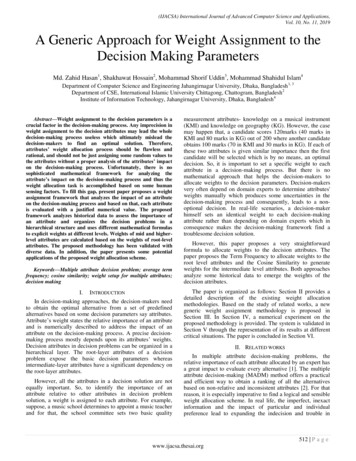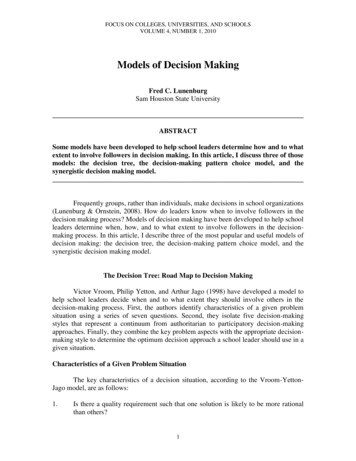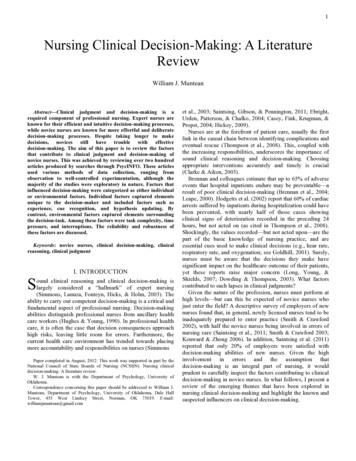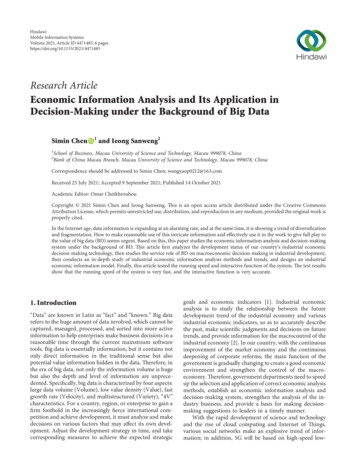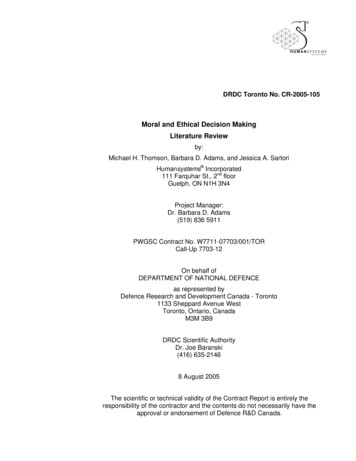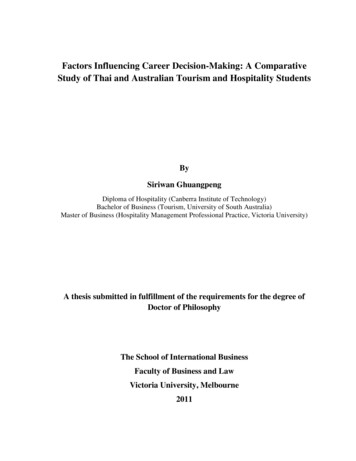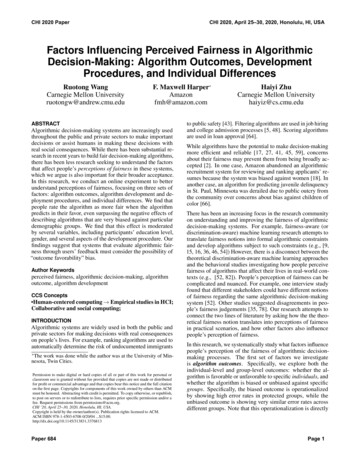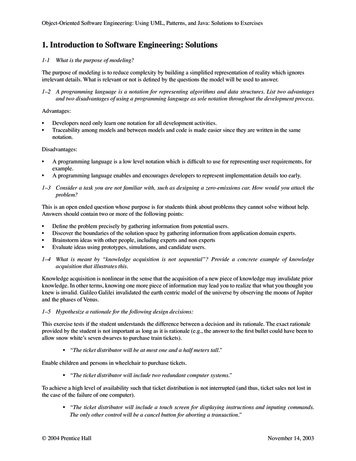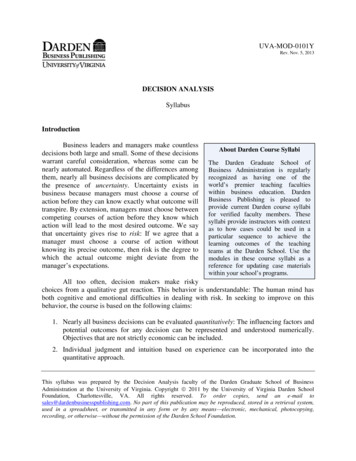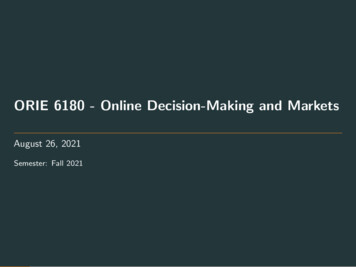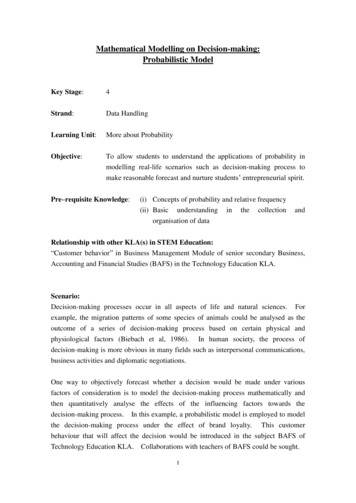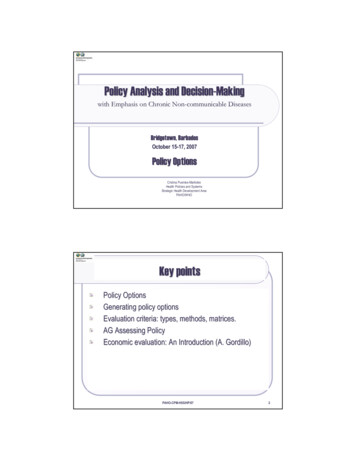
Transcription
Policy Analysis and Decision-Makingwith Emphasis on Chronic NonNon-communicable DiseasesBridgetown, BarbadosOctober 1515-17, 2007Policy OptionsCristina Puentes-MarkidesHealth Policies and SystemsStrategic Health Development AreaPAHO/WHOKey pointsPolicy OptionsGenerating policy optionsEvaluation criteria: types, methods, matrices.AG Assessing PolicyEconomic evaluation: An Introduction (A. Gordillo)PAHO-CPM-HSS/HP/072
Before defining options of solution to thepolicy problem, evaluation criteria related tothe results of the selection of thesealternatives need to be defined.PAHO-CPM-HSS/HP/073Policy goals are established. (Reduce CVD among xxx,increase levels of physical activity, etc.)These goals express what the policy should achieve interms of the solution of the problem. (outcome)These goals are translated into objectives, moreconcrete statements about the future results that aredesired.PAHO-CPM-HSS/HP/074
Goals, Objectives, Criteria and MeasuresGoals: formal, broad statement about desired longlong-run achievementsreduce povertyObjectives: focused, concrete statement about end statesreduce % pop on welfareCriteria: dimensions of the objectives used to evaluate alternativealternativepoliciescost; political viabilityMeasures: tangible operational definitions of criteriacost per 1% reductionPAHO-CPM-HSS/HP/075In the field of policy analysis .Criteria are evaluative standards that guide the processes ofdecision making.They allow ranking policy options in order of preference.preference.The most important evaluative criterion is that the projectedoutcome will solve the policy problem to an acceptable degree.Criteria can be measures, rules, standards, and all those attributesattributesconsidered relevant by the decision maker (individual or group) in agiven situation.PAHO-CPM-HSS/HP/076
More on criteriaEvaluation criteria are measurable dimensions that serveto compare and rank the policy alternatives.They are used to judge the outcomes of implementing thealternatives.For each alternative you list, project all of the outcomes(or impacts) that you or other interested parties mightreasonably care about.PAHO-CPM-HSS/HP/077A good criterion should beClearConsistentSupported by measuresPAHO-CPM-HSS/HP/078
Commonly Used Evaluative CriteriaLegal Feasibility: Consistency with current constitutional/legal framework,national/federal/state/local mandates as appropriate.Political Viability: Acceptability of the policy option to various relevant stakeholders thathold political power (voters, legislators, president’s cabinet, etc.)Sustainability: Ability of the policy option to maintain its beneficial effects in the longerterm.Social/Cultural Feasibility: Consistency with national/local traditions, policies andinstitutions; acceptable for the local population.Technical Feasibility: Availability of necessary resources and competencies.Administrative Feasibility: Degree of ease of implementation, financial/managerial factors.Cost Effectiveness: Achieving policy goals at the least cost.Economic Efficiency: Maximization of satisfaction by society.PAHO-CPM-HSS/HP/079In public health, additional criteria may include:Equity (fair social allocation (distribution) of burdens (may be costs) and benefits amongsocial groupsEconomic and social costs of a disease/injury; loss of productivity, medical costs,etc.Need to act quickly (e.g. to mitigate a disaster, to control the spread of a disease).Burden of disease (e.g. measured by the relative number of people dead –mortality-; measured by the relative number of people affected –morbidity, other).Effect of the problem on special populations (lower income, women, children,the disabled, aged, etc.) or on the physical environment.SafetyPrivacyPAHO-CPM-HSS/HP/0710
CriteriaExamples of Different Types of s a valued outcome been achieved?Units of serviceEfficiencyMaximize the net benefits for all individuals.Unit cost, net benefits,costcost-benefit ratio[EquityValue judgment. It refers to the fair socialallocation (distribution) of burdens (may becosts) and benefits among social groupsVarious/ParetoVarious/Pareto criterion,KaldorKaldor-Hicks criterion,Rawls criterionResponsivenessPolicy outcomes satisfy the needs,preferences or values of particular groups.Consistency with citizensurveys.AppropriatenessDesired outcomes (objectives) are worthy and Public programs shouldvaluable.be equitable as well asefficient.PAHO-CPM-HSS/HP/0711An Example: Priority Setting Criteria for Research at theNational Institutes of Health, USAPublic health needsScientific quality of researchPotential for scientific progress (e.g. existence ofpromising pathways and qualified researchers)Diversification of the portfolio expand researchAdequate infrastructure support (e.g. human capital,equipment, instruments, facilities).PAHO-CPM-HSS/HP/0712
Example (Cont.)Each criteria is operationalized, see example for publichealth needsPublic health needsScientific quality of researchPotential for scientific progress.Diversification of the portfolio toexpand researchAdequate infrastructure support. Number of people that suffer from aparticular disease. Number of deaths caused by thedisease. Degree of disability caused by thedisease. Degree in which the diseaseshortens a normal, productive andcomfortable life Economic and social costs of thedisease. Need to act quickly to control thespread of the disease.PAHO-CPM-HSS/HP/07Defining Policy Options13
How can I identify policy options?Keep the current system (do nothing)Modify the current system (tweak or embark onmore profound changes)Use an existing design (maybe that works inanother part of the country for a similar problem andpopulation)Create a new designCombinations?PAHO-CPM-HSS/HP/0715Policy options may also be of different natureTechnical (add or expand services, facilities)Managerial (modify the current operation of the systemor service)Economic/Financial (change the prices charged, modifytaxes, etc.)RegulatoryPAHO-CPM-HSS/HP/0716
Suggestions for developing policy optionsEssential to understand causes, associations and contexts andthus structure the problem adequately; it will help to developeffective interventions/programs (to solve the problem)Identify various different options, then narrow byAggregating related optionsDropping irrelevant optionsDescribe each option in depthBe explicit about status quo option (implications, costs, politicalrepercussions, etc.)PAHO-CPM-HSS/HP/0717How to Develop Policy OptionsIf no policy exists, begin from generic alternatives.If there is a current policy, use it as a base and then gradually modifycomponents of current policy. That is, add, reduce, substitute, combine or split,eliminate, reorient, switch, new components, approaches, resources, modifytiming, try different forms of financing, etc.)Develop typologies, use analogies and/or metaphors.Compare the various alternatives with real experiences or with an ideal situation.Consult with experts and stakeholders (brainstorm, debate, use mail surveys,public hearings, focus groups, formal and informal meetings, etc.).Specify a range of alternatives that include at least:Maintain or modify the current system.Apply a policy design that has been tried and tested in other settingsCreate a new one.Do nothing (current policy as base).PAHO-CPM-HSS/HP/0718
SuggestionsDon’t wait to find the perfect option.Compare preferred policy with those already inexistence.Estimate all the alternatives in terms of the establishedgoals.Ensure that the alternatives are mutually exclusive.Avoid alternatives that are too broad or lack specificity.Try to ensure that the options are consistent with theavailable resources.PAHO-CPM-HSS/HP/0719For example, considering the policy problem of morbidity and mortality due totraffic accidents mainly caused by behavioral factors related to limited used ofseat belts and to drinking an driving, we know that the following may reduce thenthe severity of the problem:1.2.3.4.5.6.Wearing a shoulder and lap restraintSeat belt use (saves over 26 billion dollars a year if use wereuniversal).Air bags and seat belts.Use of child restraints.Motorcycle and bicycle helmets.Reducing the number of drivers that drink and drive.PAHO-CPM-HSS/HP/0720
Therefore, we may develop the following alternatives:Enforce existing laws to ensure that:All drivers wear a shoulder and lap restraint.All children use appropriate car seats and child restraints.All motorcycle and bicycle riders use helmets1.Develop and implement health education and promotion strategies to modifybehavioral factors related to driver fatigue, driver distraction (talking to passengers,attending to children, eating or drinking, personal grooming, looking at maps, reading,attention to electronic devices and verbal exchanges).2.Develop and implement health education strategies to reduce risky driver behaviors(drinking and driving, exceeding the posted speed limit, and aggressive driving.)3.Establish automated systems for enforcing speed limit and red light laws.4.Establish graduated drivers licensing laws that put limits on drivers aged 16–18 (orwhatever the driving age in the country).5.Promote transportation policies that encourage mass transit, walking, and cycling.6.Enforce motor vehicle safety standards.7.Reduce the number of days or hours of operation of liquor stores and bars.8.A combination of the alternatives mentioned above.9.Alternative 1 Alternative 2 Alternative 310.Aternative 2 Alternative 311.Alternative 5 Alternative 912.Alternative 4 Alternative 3tc.PAHO-CPM-HSS/HP/07Policy OptionsEnforce existing laws to ensure that: all drivers wear a shoulderand lap restraint, all children use appropriate car seats and childrestraints, all motorcycle and bicycle riders use helmetsDevelop and implement health education and promotion strategiesto modify behavioral factors related to driver fatigue, driverdistraction (talking to passengers, attending to children, eating ordrinking, personal grooming, looking at maps, reading, attention toelectronic devices and verbal exchanges).Develop and implement health education strategies to reduce riskydriver behaviors (drinking and driving, exceeding the posted speedlimit, and aggressive driving.)Establish automated systems for enforcing speed limit and redlight laws.Establish graduated drivers licensing laws that put limits on driversaged 16–18 (or whatever the driving age in the country).Establish/enforce transportation policies that encourage masstransit, walking, and cycling.Enforce motor vehicle safety standards.Reduce the number of days or hours of operation of liquor storesand bars.A combination of the alternatives mentioned above.Alternative 1 Alternative 2 Alternative 3Aternative 2 Alternative 3Alternative 5 Alternative 9Alternative 4 Alternative 3Etc.21Possible IssuesProven very cost effective options, needs to be accompanied bybehavioral change strategies.Effective but long term and may involve high costs, new legislation.Effective but long term and may involve high costs.Evidence shows that running red lights is the most common causeof urban crashes. Changing this behavior may be accomplishedmore effectively in the short term with installation of red lightcameras which has proven effective in reducing collisions. Mayinvolve initial installation costs of lights and sensors.Effective, but may require new regulations and initial costs.Behavior change may consume a great deal of financialresources; results may be too long term and effectiveness notalways proven.Enforcing traffic laws in dense urban areas by traditional meansposes special difficulties for police. It endangers motorists andpedestrians as well.Possible strong opposition from liquor store and bar owners whowould lose revenues, as well as from some groups of consumers.May also require new legislation, create loss of revenue.PAHO-CPM-HSS/HP/0722
Example: If the goal were to have fewer deaths and injuries as possiblefrom traffic accidents, what would be the most important considerationsto achieve the goal:Is it cost (to the hospitals? To the government? To the population? To certaingroups in the population?)Is it equity (reduction among certain age groups at risk (males, teenagers, elderly?Other high risk groups, such as pick up truck drivers, people living in urban areas?Is it the burden of disease to certain population groups? Loss of social andeconomic productivity of teenagers, etc.?)Is it effectiveness (of measures, such as use of seat belts or child restrainingseats?)And so on.We would also need to establish the meaning of “fewer death and injuries” sinceachieving 100% is not possible. Then, how much is fewer? For which injuries?What percentage? For which groups? In which neighborhoods?PAHO-CPM-HSS/HP/0723Screening AlternativesProblem AnalysisLarge number of impactsLarge number of possible alternativesEstimation of all impacts for all alternatives is impossible (and(and not worthwhile)Costly and time consumingMany will have similar impactsSome will be dominated by othersSolutions to problemIncomplete analysisIgnore some impactsExamine few alternativesAdd a screening stepBroadBroad-brush examination of wide range of alternatives,Eliminate unpromising alternatives,Retain promising alternatives for detailed analysisWeimer and Vining24
Deployment and Assessment of OptionsCriteriaEffectivenessPolitical tyDegree to which the option addresses orresponds to the problem.Consistency with government priorities.Public perception.Effect on tax payers.Impact on the private sector.Complexity and timing of implementation.Fiscal impact on government.Legal, jurisdictional or commercial restrictions.Economic cost benefit.Environmental cost benefit.Disproportionate impact on some socialgroups or regions.PAHO-CPM-HSS/HP/0725The Goals/Alternative MatrixRanking alternatives according to criteria is a priority setting exercise.Matrix is useful to illustrate the comparison of alternatives accordingaccording to the criteriaestablished once the relative weights have been established.Policy consequences are rarely linear:the results of a program may in fact give rise to additional issuesissues or problems in thesame or other areas or sectors.Therefore, policy alternatives need to be compared not only in termsterms of the desiredoutcomes (or goals), but also in terms of the possible spilloversspillovers or externalities that itsimplementation may produce.Recognize that technically sound options may not have the necessarynecessary political and/or socialsupport.Some good policies may not be easily implemented due to the financialfinancial burden that mayimpose of others.W and V26
The Goals/Alternative MatrixCriteriaOption AOption BOption CEffectivenessVery PositivePositiveNo impactFlexibilityVery tiveNegativePolitical FeasibilityHighMediumLowAdministrative hMediumLowPAHO-CPM-HSS/HP/0727Desirable Characteristics of Good Policy OptionsCharacteristicDescriptionInvulnerabilityCan function if one or more parts failsFlexibilityCan be used for more than one objective or purposeDegree of RiskDoes it have a high probability to fail?CommunicabilityIs it easily understood by those involved and affected?MeritDoes it actually address the problem at hand?Ease of ImplementationIs the option relatively easy to implement?CompatibilityIs it compatible with existing norms and procedures?EvaluabilityAre policy outcomes measurable, would they allow monitoring and evaluation?ReversibilityHow difficult is it to return to previous conditions should the option fail?StabilityWould it work even when conditions change?EthicalIf appropriate, is the option ethical?ReliabilityHas it been tried elsewhere with success?Adapted from Walker Warren, RAND Europe28
A final thought .“The definition of the alternatives is the supremeinstrument of power because the definition ofalternatives is the choice of conflicts, and the choice ofconflicts allocates power.”Schattschneider, E.E. (1975). The Semisovereign People: Arealist's view of democracy in America. Hinsdale, Illinois: The Dryden Press.PAHO-CPM-HSS/HP/0729Suggested Reading(s)Anand, Sudhir, F. Peter and A. Sen. Public Health,, Ethics and Equity. (2004) Oxford University Press. (pp. 1533 and 93-106).Kraft, M. and Scott Furlong. Public Policy: Politics, Analysis and Alternatives. (2004). CQ Press, Chapter 6:Assessing Policy Alternatives.Munger, Michael. Analyzing Policy: Choices, Conflicts and Practice. (2000). New York: W.W. Norton. (Chapter11, Cost Benefit Analysis)Marc Suhrcke, Rachel A. Nugent, David Stuckler and Lorenzo RoccoChronic Disease: An EconomicPerspectiveLondon: Oxford Health Alliance icperspective.pdfPal, Less (2000). “There ought to be a law!” Instrument choice: an overview of the issues. Carleton UniversityResearch and Statistics Division. CA. Strategic Issues Series. 2/rp2002-10.pdfPatton, C. y D. Sawicki. (1993) Basic Methods of Policy Analysis and Planning. Englewood Cliffs, NJ: PrenticeHall. Second edition. (Chapter 8: Displaying Alternatives and Distinguishing among Them.)Rice, Thomas. (April 1997). Can markets give us the health system we want? Journal of Health Politics, Policyand Law. 22(2): 383-425.Stone, D. (2001) Policy Paradox: The Art of Political Decision-making. Revised Edition. New York: W. W.Norton & Co., pp. 163-187 (Numbers). (Handout)US Department of Health and Human Services. (1997) Cost-Effectiveness in Health & Medicine. USDHHS,Washington DC. (Chapters 1 and 2, Pp. 1-33, Cost-Effectiveness Analysis as a Guide to Resource Allocationin Health: Roles and Limitations; Theoretical Foundations of Cost-Effectiveness Analysis).Weimer, David L. and Aidan R. Vining. Policy Analysis: Concepts and Practice. 3rd edition. (2004). PrenticeHall. (Chapter 11: Goals/Alternatives Matrices.)PAHO-CPM-HSS/HP/0730
PAHO-CPM-HSS/HP/07 7 More on criteria Evaluation criteria are measurable dimensions that serve to compare and rank the policy alternatives. They are used to judge the outcomes of implementing the alternatives.
